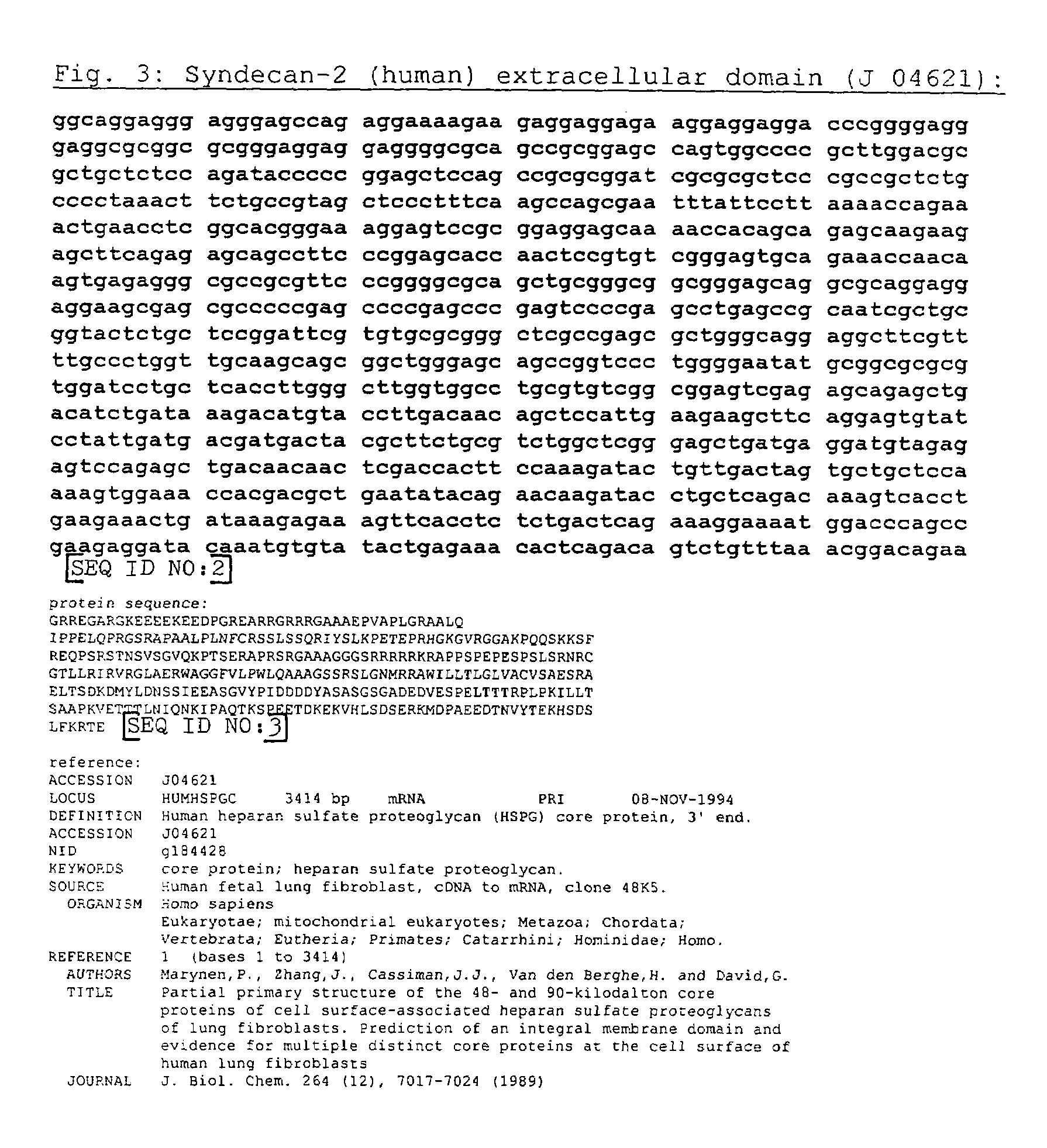Stimulation of angiogenesis via enhanced endothelial expression of syndecan-4 core proteins
- Summary
- Abstract
- Description
- Claims
- Application Information
AI Technical Summary
Problems solved by technology
Method used
Image
Examples
experiment 1
[0103]The immortalized human endothelial cell line ECV304 was transfected with prepared retroviral constructs containing full length cDNAs for either syndecan-4 or glypican-1. In addition, in order to differentiate potential biological effects secondary to increased mass of cell surface and / or extracellular heparan sulfates versus increased core protein expression, two additional chimera core protein constructs were created. In one, S4-GPI, syndecan 4 extracellular domain was linked to the glypican 1 GPI anchored; and in another, G1-S4c, the extracellular domain of glypican 1 was linked to the transmembrane and cytoplasmic domains of syndecan-4. Cells transfected with a vector only construct (ECV-VC) were used as control. Increased expression of both syndecan-4 and glypican-1 constructs was expected to result in larger numbers of heparan sulfate chains on the cell surface.
[0104]Subsequently, the total mass of heparan sulfate chains on the wild type as well as the 4 newly generated t...
experiment 2
[0108]To study the effect of syndecan-4 and glypican-1 expression on endothelial cell growth, the ability of wild type and newly created ECV cell lines to grow in-vitro in response to serum and bFGF was analyzed. Experimentally, all cells were growth arrested for 48 hours and then stimulated with 0.25% FBS supplemented with 25 ng / ml bFGF. The data is shown by FIG. 14 in which, MSCV-ECV-vector control; G1: glypican-1 full length cDNA; S4-GPI; syndecan-4 extracellular domain linked to the GPI anchor; S4: full length syndecan-4 cDNA; G1-S4c: extracellular domain of glypican-1 linked to syndecan-4 transmembrane / cytoplasmic domain.
[0109]As shown therein, the ECV-S4 and ECV-G1-S4c cells demonstrated a 4-fold increase in cell number compared to ECV wild type or vector-transfected (MSCV) cells. At the same time, growth of ECV-G1 or ECV-S4-GPI cells did not differ significantly from wild type ECV cells. Even though both ECV-G1 and ECV-S4-GPI clones had somewhat smaller numbers of bFGF-HS bin...
experiment 3
[0110]To test the effect of these constructs expression on the cells ability to form vascular structures, wild type and newly generated ECV clones were plated on Matrigel in 10% FBS-DMEM. Three days later, the presence of definable structures (cords and rings) was assayed by light microscopy. As in the case of in-vitro growth assays, ECV-S4 and ECV-G1-S4c cells formed more numerous and denser vascular structures compared to wild type ECV, ECV-G1 or ECV-S4-GPI cells. The results are shown by FIGS. 15A–15C.
[0111]As seen in FIGS. 15A–15C respectively, vector transduced ECV cells (MSCV) as well as ECV transduced with full length syndecan-4 and G1-S4c construct-carrying retroviruses were plated on growth factor depleted Matrigel supplemented with 25 ng / ml bFGF. Photographs of the gels were taken 72 hours later. Note the presence of increased vascular networks and cell density in S4 and G1-S4c panels compared to MSCV panel.
PUM
| Property | Measurement | Unit |
|---|---|---|
| Time | aaaaa | aaaaa |
| Fraction | aaaaa | aaaaa |
| Mass | aaaaa | aaaaa |
Abstract
Description
Claims
Application Information
 Login to View More
Login to View More - R&D Engineer
- R&D Manager
- IP Professional
- Industry Leading Data Capabilities
- Powerful AI technology
- Patent DNA Extraction
Browse by: Latest US Patents, China's latest patents, Technical Efficacy Thesaurus, Application Domain, Technology Topic, Popular Technical Reports.
© 2024 PatSnap. All rights reserved.Legal|Privacy policy|Modern Slavery Act Transparency Statement|Sitemap|About US| Contact US: help@patsnap.com










